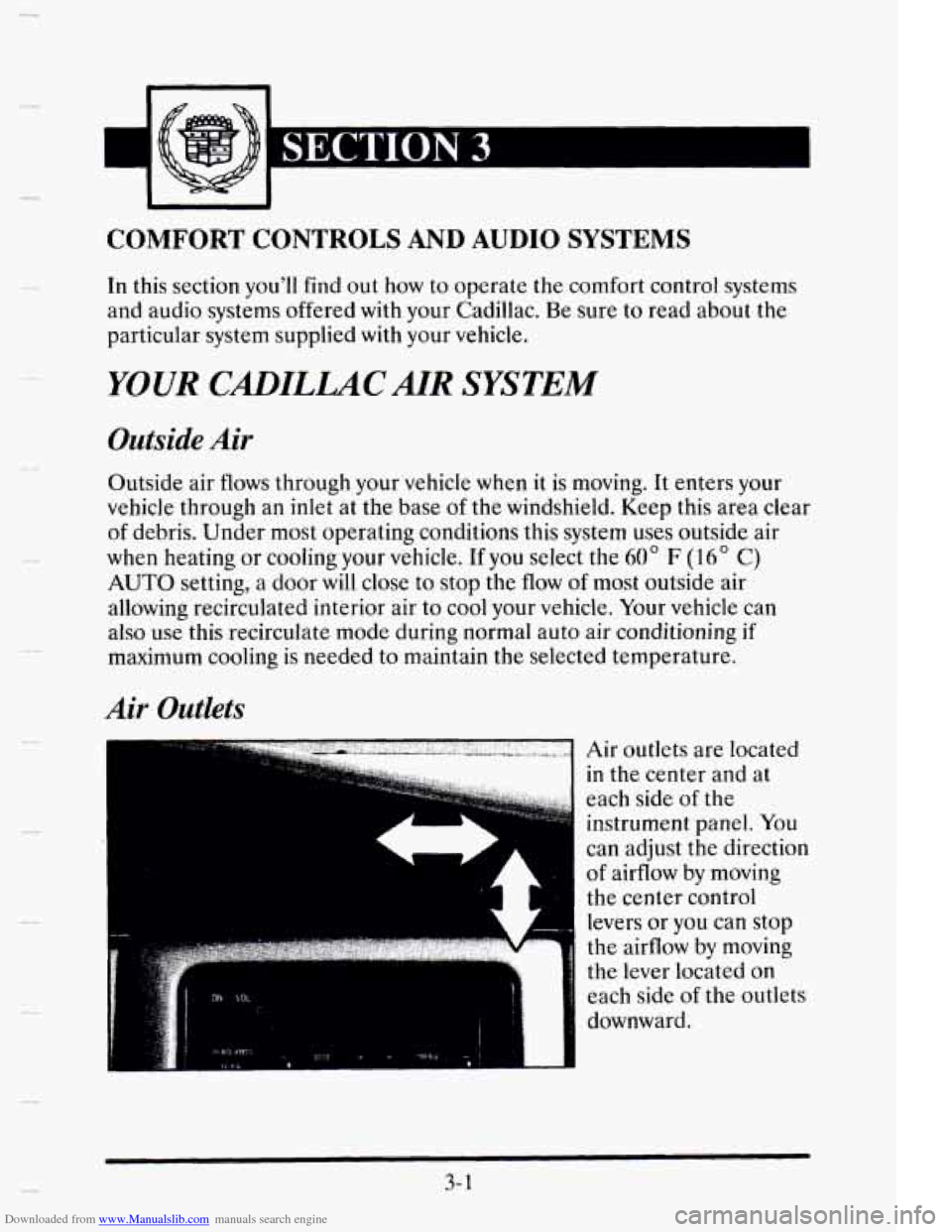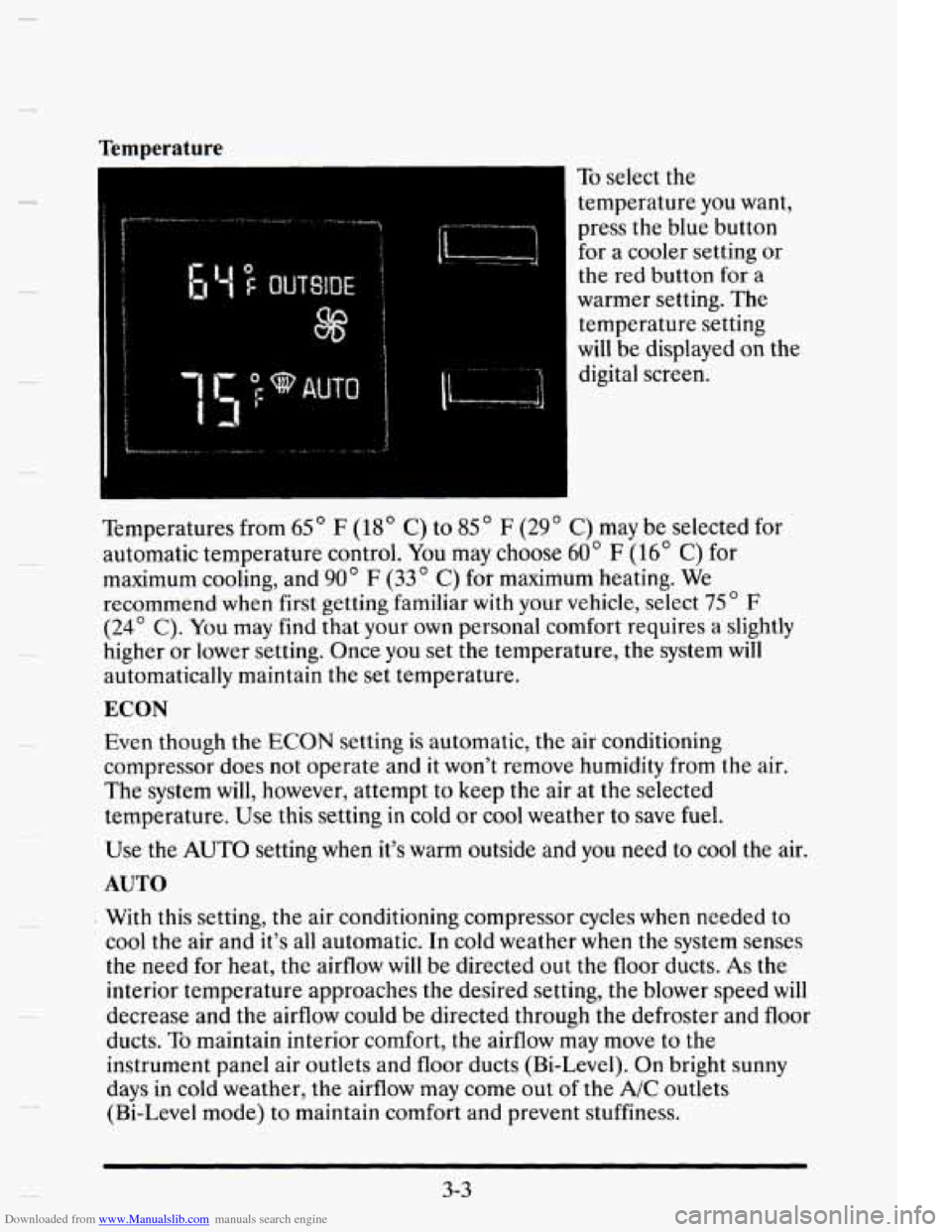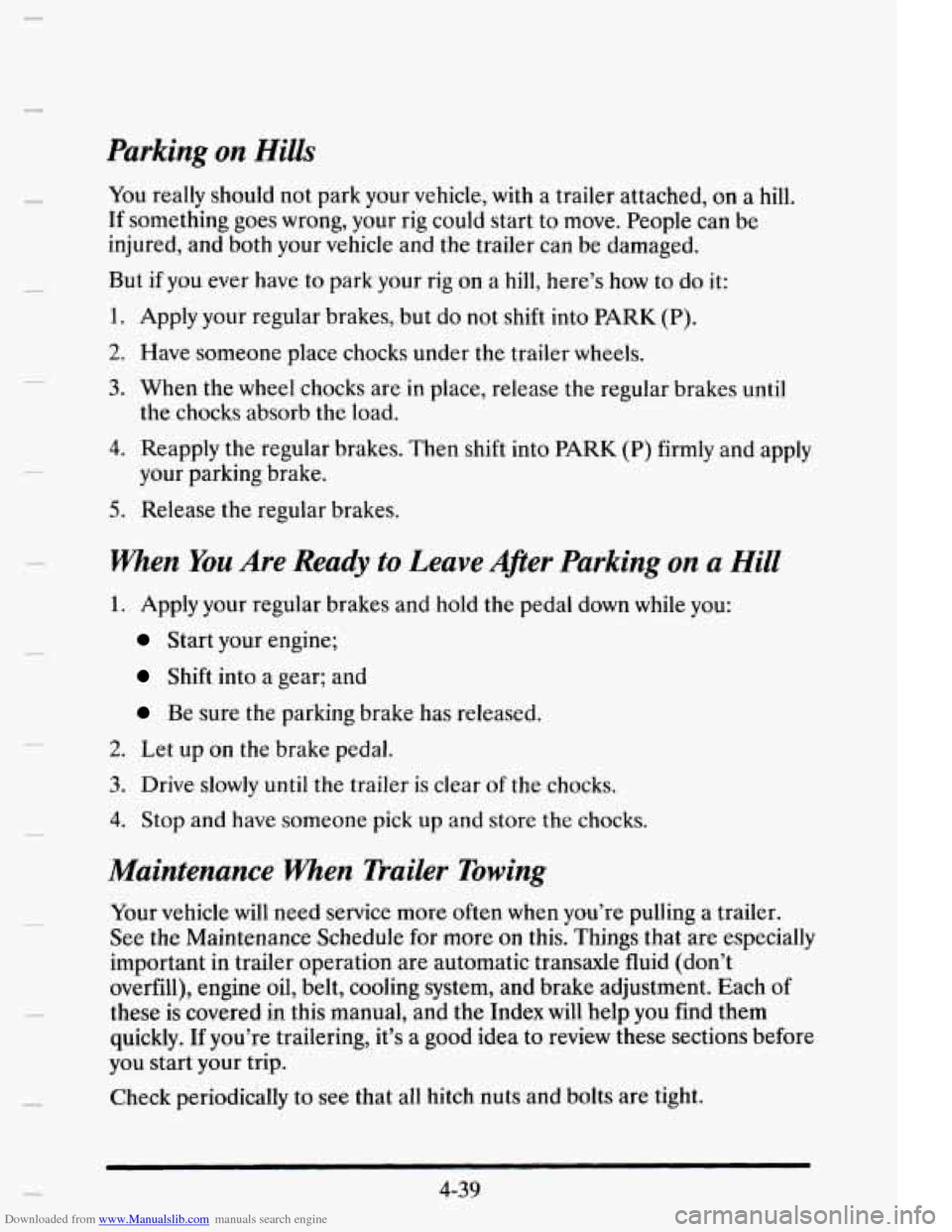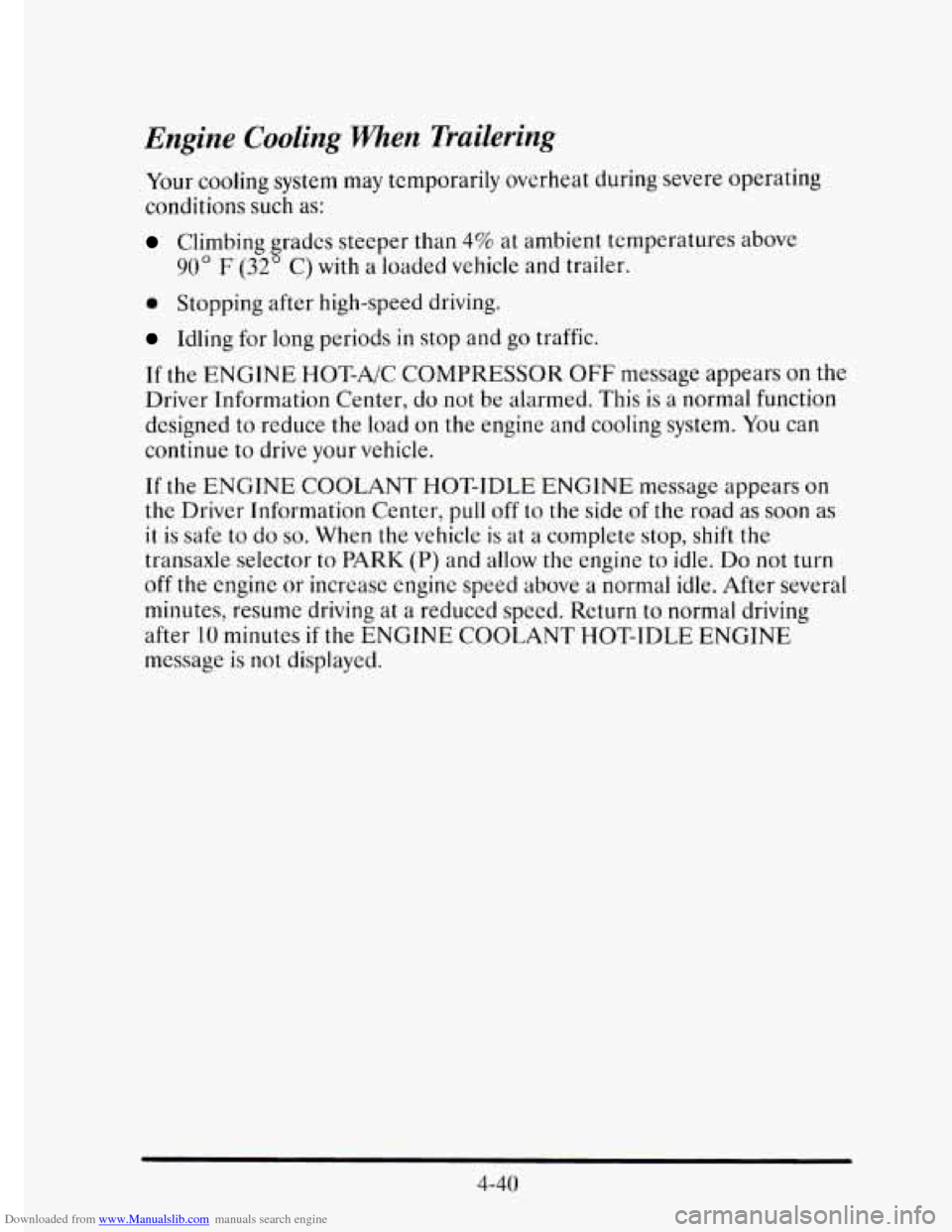Page 158 of 395

Downloaded from www.Manualslib.com manuals search engine BATTERY VOLTS LOW - 06
This message will appear when the electrical system is charging less than
10 volts or if the battery has been drained. If this message appears
immediately after starting,
it is possible that the generator can still
recharge the battery. The battery should recharge after driving a few miles
and the message should go out. If this message appears while driving or
after starting your vehicle and stays on, have
it checked immediately to
determine the cause
of this problem. To help the generator recharge the
battery quickly you can reduce the load on the electrical system by turning
off your accessories. You can monitor battery voltage on
the Driver
Information Center by toggling the
INFORMATION button. The normal
range
is 11.5 to 15.5 volts.
CHANGE TRANS FLUID - 47
This message will appear when it is time to replace the transaxle fluid. See
your maintenance schedule booklet for the proper fluid and change
intervals.
CHECK BRAKE FLUID - 37
This message is displayed to inform the driver that the brake reservoir
fluid level is low. Check
the brake reservoir level and add as needed. Have
the brake system serviced by a Cadillac technician as soon as possible.
If the brake warning light is on, follow the directions in that part.
CHECK COOLANT LEVEL - 04
This message will appear when there is a low level of engine coolant.
Have the cooling system serviced by a Cadillac technician as soon as
possible.
CHECK FUEL GAGE - 39
This message will appear when your fuel supply is less than four gallons
and your display is turned off.
2-87
Page 166 of 395

Downloaded from www.Manualslib.com manuals search engine COMFORT CONTROLS AND AUDIO SYSTEMS
In this section you'll find out how to operate the comfort control systems
and audio systems offered with your Cadillac. Be sure to read about the
particular system supplied with your vehicle.
YOUR CADILLACAIR SYSTEM
Outside Air
Outside air flows through your vehicle when it is moving. It enters your
vehicle through an inlet
at the base of the windshield. Keep this area clear
of debris. Under most operating conditions this system uses outside air
when heating or cooling your vehicle.
If you select the 60" F (16" C)
AUTO setting, a door will close to stop the flow of most outside air
allowing recirculated interior air to cool your vehicle. Your vehicle can
also use this recirculate mode during normal auto air conditioning if
maximum cooling is needed to maintain the selected temperature.
Air Outlets
Air outlets are located
in the center and at
each side
of the
instrument panel. You
can adjust the direction
of airflow by moving
the center control
levers
or you can stop
the airflow by moving
the lever located on
each side
of the outlets
downward.
3- 1
Page 168 of 395

Downloaded from www.Manualslib.com manuals search engine i.
Temperature
To select the
temperature you want,
press the blue button
for a cooler setting or
the red button for a
warmer setting.
The
temperature setting
will be displayed on the
digital screen.
Temperatures from
65 ' F (18' C) to 85 " F (29 ' C) may be selected for
automatic temperature control.
You may choose 60" F (16' C) for
maximum cooling, and
90' F (33" C) for maximum heating. We
recommend when first getting familiar with your vehicle, select
75 ' F
(24' C). You may find that your own personal comfort requires a slightly
higher or lower setting. Once you set the temperature, the system will
automatically maintain the set temperature.
ECON
Evert though the ECON setting is automatic, the air conditioning
compressor does not operate and it won't remove humidity from the air.
The system will, however, attempt to
keep the air at the selected
temperature.
Use this setting in cold or cool weather to save fuel.
Use the AUTO setting when it's warm outside and you need to cool the air.
AUTO
With this setting, the air conditioning compressor cycles when needed to
cool the air and it's all automatic. In cold weather when the system senses
the need for heat, the airflow will be directed out the floor ducts.
As the
interior tempcrature approaches the desired setting, the blower speed
will
decrease and the airflow could be directed through the defroster and floor
ducts.
To maintain interior comfort, the airflow may move to the
instrument panel air outlets and floor ducts (Bi-Level). On bright sunny
days in cold weather, the airflow may come out
of the A/C outlets
(Bi-Level mode) to maintain comfort and prevent stuffiness.
3-3
Page 171 of 395
Downloaded from www.Manualslib.com manuals search engine In some cold start conditions, the AUTO blower fan speed may be limited
until the engine cooling system warms up. This is normal to prevent
windshield fogging.
It will help if you first clear any ice and snow from the hood and the air
inlet (it’s between the hood and the windshield).
REAR DEFOGGER
-1 Press this button to
turn on the rear
defogger.
With it, your rear window and both outside rearview mirrors are heated.
The system will automatically shut off after 10 minutes. If further
defogging is desired, simply press the button again.
NOTICE:
Scraping the inside of your rear window could cut and damage
the heating grids. Your warranty would not cover this damage.
And don’t put decals there; you might have
to scrape them off.
3-6
Page 211 of 395
Downloaded from www.Manualslib.com manuals search engine HILL AND MOUNTMN ROADS
Driving on steep hills or mountains is different from driving in flat or
rolling terrain.
If you drive regularly in steep country, or if you’re planning to visit there,
here are some tips that can make your trips safer and more enjoyable.
0 Keep your vehicle in good shape. Check all fluid levels and also the
brakes, tires, cooling system and transaxle. These parts can work hard
on mountain roads.
Know how to go down hills. The most important thing to know is this:
let your engine do some
of the slowing down. Shift to a lower gear
when you
go down a steep or long hill.
4-24
Page 226 of 395

Downloaded from www.Manualslib.com manuals search engine Parking on Hills
c
You really should not park your vehicle, with a trailer attached, on a hill.
If something goes wrong, your rig could start to move. People can be
injured, and both your vehicle and the trailer can be damaged.
But
if you ever have to park your rig on a hill, here’s how to do it:
1. Apply your regular brakes, but do not shift into PARK (P).
2. Have someone place chocks under the trailer wheels.
3. When the wheel chocks are in place, release the regular brakes until
the chocks absorb the load.
4. Reapply the regular brakes. Then shift into PARK (P) firmly and apply
5. Release the regular brakes.
your parking
brake.
When You Are Ready to Leave Afier Parking on a Hill
1. Apply your regular brakes and hold the pedal down while you:
Start your engine;
Shift into a gear; and
Be sure the parking brake has released.
2. Let up on the brake pedal.
3. Drive slowly until the trailer is clear of the chocks.
4. Stop and have someone pick up and store the chocks.
Maintenance When Trailer Towing
Your vehicle will need service more often when you’re pulling a trailer.
See the Maintenance Schedule
for more on this. Things that are especially
important in trailer operation are automatic transaxle fluid (don’t
overfill), engine oil, belt, cooling system, and brake adjustment. Each
of
these is covered in this manual, and the Index will help you find them
quickly.
If you’re trailering, it’s a good idea to review these sections before
you start your trip.
Check periodically to see that all hitch nuts and bolts are tight.
4-39
Page 227 of 395

Downloaded from www.Manualslib.com manuals search engine Engine Cooling When Trailering
Your cooling system may temporarily overheat during severe operating
conditions such as:
Climbing gradcs steeper than 4% at ambient temperatures above
90" F (32" C) with a loaded vehicle and trailer.
0 Stopping after high-speed driving.
Idling for long periods in stop and go traffic.
If the
ENGINE HOT-A/C COMPRESSOR OFF message appears on the
Driver Information Center,
do not be alarmed. This is a normal function
designed to reduce the load
on the engine and cooling system. You can
continue to drive your vehicle.
If the ENGINE COOLANT HOT-IDLE ENGINE message appears on
the Driver Information Center, pull off to the side of the road as soon as
it
is safe to do so. When the vehicle is at a complete stop, shift the
transaxle selector
to PARK (P) and allow the engine to idle. Do not turn
off the engine
or increase engine speed above a normal idle. After several
minutes, resume driving at
a reduced speed. Return to normal driving
after
1.0 minutes if the ENGINE COOLANT HOT-IDLE ENGINE
message is not displayed.
4-40
Page 242 of 395
Downloaded from www.Manualslib.com manuals search engine r
COOLING SYSTEM
When you decide it’s safe to lift the hood, here’s what you’ll see:
A. Coolant surge tank with pressure cap.
B. Electric engine fans.
5-15